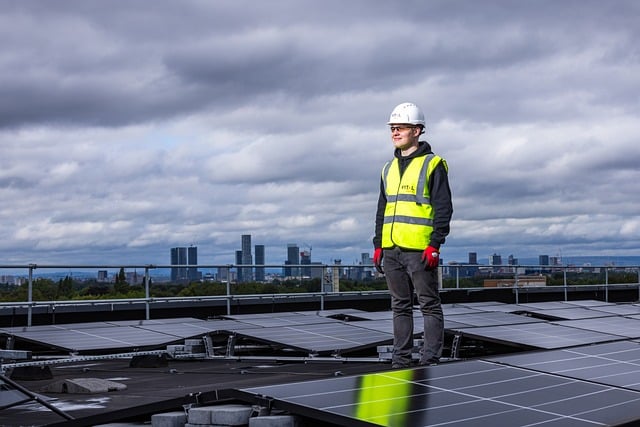“Swift Solutions for Solar Inverter Snags!”
Solar inverters are crucial components of solar energy systems, converting the direct current (DC) generated by solar panels into alternating current (AC) for use in homes and businesses. However, like any technology, they can encounter issues that may disrupt energy production. Understanding common solar inverter problems and their quick fixes can help maintain system efficiency and minimize downtime. This guide outlines typical inverter issues, their symptoms, and straightforward solutions to ensure your solar energy system operates smoothly.
Troubleshooting Overheating Issues in Solar Inverters
Overheating issues in solar inverters can pose significant challenges for homeowners and businesses relying on solar energy systems. When an inverter overheats, it can lead to reduced efficiency, potential damage, and even system shutdowns. Therefore, understanding how to troubleshoot these overheating problems is essential for maintaining optimal performance.
First and foremost, it is crucial to identify the signs of overheating. Common indicators include the inverter shutting down unexpectedly, warning lights activating, or a noticeable increase in temperature on the unit’s exterior. If you observe any of these symptoms, the first step is to check the inverter’s installation location. Inverters should be installed in a well-ventilated area, away from direct sunlight and heat sources. If the inverter is located in a confined space, consider relocating it to a more open area or enhancing ventilation through the installation of fans or vents.
Moreover, dust and debris can accumulate on the inverter’s surface and within its cooling vents, obstructing airflow and causing overheating. Regular maintenance is essential in this regard. Cleaning the inverter with a soft brush or cloth can help remove any buildup that may hinder its cooling capabilities. Additionally, ensure that the surrounding area is free from obstructions that could impede airflow. This simple step can significantly improve the inverter’s ability to dissipate heat.
Another critical factor to consider is the inverter’s load capacity. If the inverter is consistently operating at or near its maximum capacity, it may struggle to manage heat effectively. To address this issue, evaluate the energy consumption of your solar system. If you find that your energy needs have increased since the inverter was installed, it may be time to upgrade to a more powerful model. Consulting with a solar energy professional can provide insights into whether your current inverter is suitable for your energy demands.
In some cases, overheating can be attributed to electrical issues, such as poor connections or faulty wiring. Inspecting the wiring and connections for signs of wear, corrosion, or damage is essential. Loose connections can generate heat, leading to overheating. If you identify any problematic areas, it is advisable to tighten connections or replace damaged components. However, if you are not comfortable performing these checks yourself, seeking assistance from a qualified technician is recommended to ensure safety and compliance with electrical standards.
Additionally, monitoring the inverter’s performance through its built-in diagnostic tools can provide valuable insights into its operating conditions. Many modern inverters come equipped with monitoring systems that can alert you to potential issues before they escalate. By regularly reviewing performance data, you can identify trends that may indicate overheating or other problems, allowing for proactive measures to be taken.
Lastly, consider the ambient temperature where the inverter operates. Inverters are designed to function within specific temperature ranges, and extreme heat can lead to overheating. If your inverter is located in an area that experiences high temperatures, such as an uncooled garage or attic, consider installing a cooling system or relocating the inverter to a more temperature-controlled environment.
In conclusion, troubleshooting overheating issues in solar inverters involves a combination of proper installation, regular maintenance, and vigilant monitoring. By taking these steps, you can ensure that your solar inverter operates efficiently and effectively, ultimately prolonging its lifespan and enhancing the overall performance of your solar energy system.
Resolving Communication Errors Between Inverter and Solar Panels

Communication errors between solar inverters and solar panels can be a frustrating issue for homeowners and businesses alike. These errors can disrupt the efficiency of a solar energy system, leading to reduced energy production and potential financial losses. Fortunately, there are several quick fixes that can help resolve these common problems, ensuring that your solar system operates smoothly and effectively.
To begin with, it is essential to understand the role of the inverter in a solar energy system. The inverter acts as the bridge between the solar panels and the electrical grid, converting the direct current (DC) generated by the panels into alternating current (AC) that can be used in homes and businesses. When communication errors occur, it often indicates a disruption in this critical connection. One of the first steps in troubleshooting these issues is to check the physical connections between the inverter and the solar panels. Loose or corroded connections can lead to communication failures, so it is advisable to inspect all wiring and connectors for any signs of wear or damage. Tightening loose connections or replacing corroded components can often resolve the issue quickly.
In addition to checking physical connections, it is also important to ensure that the inverter is properly configured. Many modern inverters come equipped with monitoring systems that provide real-time data on performance and communication status. If the inverter is not configured correctly, it may not communicate effectively with the solar panels. Accessing the inverter’s settings through its user interface or mobile app can help identify any misconfigurations. Resetting the inverter to its factory settings and reconfiguring it according to the manufacturer’s guidelines can often restore proper communication.
Another common cause of communication errors is software glitches. Just like any other electronic device, solar inverters can experience software bugs that disrupt their functionality. Regularly updating the inverter’s firmware can help mitigate these issues. Manufacturers often release updates that improve performance and fix known bugs, so checking for updates and installing them as needed is a proactive approach to maintaining your system’s efficiency. If the inverter continues to experience communication errors after a firmware update, performing a hard reset may be necessary. This process involves turning off the inverter, disconnecting it from the power source, and then reconnecting it after a brief period. This can help clear any temporary glitches that may be affecting communication.
Moreover, environmental factors can also play a significant role in communication errors. For instance, excessive shading on solar panels can lead to reduced energy production and may cause the inverter to struggle with communication. Ensuring that solar panels are free from obstructions, such as tree branches or debris, can enhance their performance and improve communication with the inverter. Additionally, extreme weather conditions, such as heavy rain or snow, can temporarily affect the system’s operation. Monitoring weather conditions and understanding how they impact your solar system can help you anticipate and address potential communication issues.
In conclusion, resolving communication errors between solar inverters and solar panels is crucial for maintaining the efficiency of a solar energy system. By checking physical connections, ensuring proper configuration, updating software, and considering environmental factors, homeowners can quickly address these common problems. Taking these proactive steps not only enhances the performance of the solar system but also maximizes the return on investment in renewable energy technology. With a little diligence and attention to detail, most communication errors can be resolved swiftly, allowing users to enjoy the full benefits of their solar energy systems.
Fixing Inverter Shutdowns Due to Low Voltage
Solar inverters play a crucial role in converting the direct current (DC) generated by solar panels into alternating current (AC) suitable for household use. However, one common issue that many solar system owners encounter is inverter shutdowns due to low voltage. Understanding the causes and solutions for this problem can help ensure that your solar energy system operates efficiently and reliably.
Inverter shutdowns often occur when the voltage from the solar panels falls below a certain threshold. This can happen for several reasons, including shading on the panels, dirt accumulation, or even a malfunctioning panel. When the voltage drops, the inverter may automatically shut down to protect itself and the connected appliances from potential damage. Therefore, the first step in addressing this issue is to conduct a thorough inspection of your solar panels. Look for any obstructions that may be casting shadows, such as overhanging branches or nearby structures. If you find any, trimming the foliage or relocating the panels may be necessary to ensure they receive adequate sunlight.
In addition to physical obstructions, dirt and debris can significantly impact the performance of solar panels. Dust, pollen, and bird droppings can accumulate over time, reducing the amount of sunlight that reaches the panels and consequently lowering the voltage output. Regular cleaning of the panels is essential to maintain their efficiency. A simple wash with water and a soft brush can often do the trick, but be sure to follow the manufacturer’s guidelines to avoid damaging the surface of the panels.
Another factor that can contribute to low voltage is the wiring and connections within the solar system. Loose or corroded connections can lead to increased resistance, which in turn can cause voltage drops. Therefore, it is advisable to inspect all wiring and connections for signs of wear or damage. Tightening loose connections and replacing any corroded components can help restore proper voltage levels and prevent future shutdowns.
Moreover, the inverter itself may be a source of the problem. If the inverter is outdated or not functioning correctly, it may not be able to handle the voltage fluctuations effectively. In such cases, checking the inverter’s settings and ensuring that it is configured correctly for your specific solar system is crucial. Some inverters have adjustable settings that can be fine-tuned to accommodate varying voltage levels. If you are unsure about how to adjust these settings, consulting the user manual or contacting a professional technician can provide valuable guidance.
In some instances, the issue may stem from the solar panels themselves. If one or more panels are underperforming due to age or damage, they may not produce sufficient voltage, leading to inverter shutdowns. Conducting a performance test on each panel can help identify any that are not functioning optimally. If you discover a faulty panel, replacing it may be necessary to restore the overall efficiency of your solar system.
In conclusion, addressing inverter shutdowns due to low voltage involves a combination of regular maintenance, thorough inspections, and timely repairs. By ensuring that your solar panels are clean, unobstructed, and properly connected, you can significantly reduce the likelihood of shutdowns and enhance the performance of your solar energy system. Taking these proactive steps not only protects your investment but also maximizes the benefits of harnessing solar energy for your home.
Addressing Inverter Error Codes: A Quick Guide
Solar inverters play a crucial role in converting the direct current (DC) generated by solar panels into alternating current (AC) that can be used in homes and businesses. However, like any electronic device, solar inverters can encounter issues that may lead to error codes. Understanding these error codes is essential for maintaining the efficiency of your solar energy system. When faced with an inverter error code, the first step is to consult the inverter’s user manual, as it typically contains a list of error codes along with their meanings and suggested solutions. This resource can provide immediate guidance, allowing you to identify the problem quickly.
One common error code is related to grid disconnection. This can occur due to fluctuations in the grid voltage or frequency, which may cause the inverter to shut down to protect itself and the solar system. If you encounter this error, check your local grid conditions and ensure that your inverter is properly connected. In some cases, simply resetting the inverter can resolve the issue. To do this, turn off the inverter, wait for a few minutes, and then turn it back on. If the error persists, it may be necessary to contact your solar provider for further assistance.
Another frequent issue is related to over-temperature conditions. Inverters are designed to operate within a specific temperature range, and excessive heat can trigger an error code. If you notice this error, first ensure that the inverter is installed in a well-ventilated area, away from direct sunlight and heat sources. Cleaning any dust or debris from the inverter’s cooling vents can also help improve airflow. If the problem continues, it may be worth checking the inverter’s specifications to ensure it is suitable for your installation environment.
Voltage-related errors are also common, particularly when there are fluctuations in the input voltage from the solar panels. If you receive a voltage error code, inspect the connections between the solar panels and the inverter. Loose or corroded connections can lead to inconsistent voltage readings. Tightening these connections or replacing any damaged components can often resolve the issue. Additionally, ensure that the solar panels are clean and free from obstructions, as dirt or debris can affect their performance and, consequently, the inverter’s operation.
In some instances, communication errors may arise between the inverter and monitoring systems. These errors can prevent you from accessing real-time data about your solar energy production. If you encounter a communication error code, check the network connections and ensure that the inverter is properly connected to your home Wi-Fi or monitoring device. Restarting the inverter and the monitoring system can also help re-establish communication.
Lastly, if you experience persistent error codes that do not resolve through these quick fixes, it may indicate a more serious issue with the inverter itself. In such cases, it is advisable to consult a qualified technician who can perform a thorough diagnostic check. Regular maintenance and monitoring of your solar inverter can help prevent many common issues, ensuring that your solar energy system operates efficiently and effectively. By being proactive and informed about these potential problems, you can maximize the performance of your solar energy system and enjoy the benefits of renewable energy with minimal interruptions.
Q&A
1. **Question:** What should I do if my solar inverter is not turning on?
**Answer:** Check the circuit breaker and ensure it is in the “on” position. Also, inspect the inverter’s display for error codes and reset the inverter if necessary.
2. **Question:** How can I resolve low power output from my solar inverter?
**Answer:** Ensure that the solar panels are clean and free from debris. Check for shading on the panels and verify that all connections are secure.
3. **Question:** What does it mean if my solar inverter is showing a fault code?
**Answer:** Fault codes indicate specific issues; refer to the inverter’s manual for the meaning of the code. Common fixes include resetting the inverter or checking for wiring issues.
4. **Question:** Why is my solar inverter making a buzzing noise?
**Answer:** A buzzing noise can be normal due to the inverter’s operation. However, if it is excessive, check for loose components or consult a technician to ensure there are no electrical issues.
Conclusion
In conclusion, addressing common solar inverter problems often involves simple troubleshooting steps such as checking connections, resetting the inverter, ensuring proper ventilation, and monitoring system performance through the inverter’s display or app. Regular maintenance and prompt attention to warning signals can prevent minor issues from escalating, ensuring optimal performance and longevity of the solar energy system.




